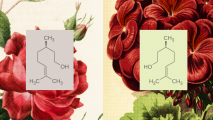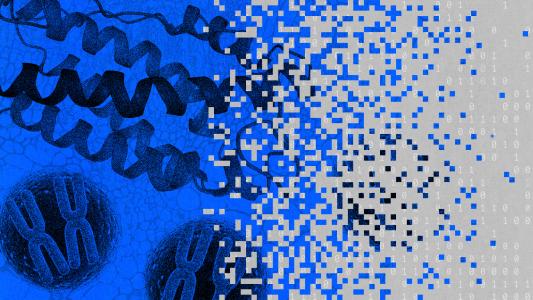For the last half century, one of the most fertile channels of scientific discovery has been Caenorhabditis elegans, a soil-dwelling roundworm known as C. elegans for short.
The one-millimeter-long animal was the first to have its entire genome sequenced and the first to have its neural network fully mapped. The simple and easy-to-manipulate creature seems to hold answers to many of nature’s most enticing questions, and curious young biologists eager to solve the biggest riddles of life are often instructed to turn their attention to the free-living nematode.
According to a growing branch of research, worms similar to C. elegans may now also possess the tools for tackling what, in recent years, has become among the most pervasive and pernicious kinds of human disease: autoimmune disorders.
The hygiene hypothesis
The Western world has seen a sharp rise in diagnoses of allergies and other immune dysfunctions since the start of the 20th century. Though the exact cause is unclear, many researchers back the “hygiene hypothesis,” which proposes that reduced exposure to infectious agents in our sanitized modern environments has left our immune systems susceptible to overreactions caused by parts of nature that were once commonplace in our lives.
Parasitic worms closely related to C. elegans may have been among the most prevalent such agents, serving as a symbiotic dam that held back the floodwaters of an overactive immune system while they lived out quiet lives within our guts. Worm eggs have been found in the remains of everyone from ancient Egyptian pharaohs to Ötzi the Iceman — the world’s oldest naturally preserved human carcass. But starting around 1900, doctors and public health organizations undertook massive campaigns to rid humans in the industrialized world of helminths, or infectious worms.
Thanks to these successful public health deworming initiatives, this dam no longer stands within the bodies of many people living in high-income countries. Now, after a century-long crusade to purge our anatomies of little squirming invaders, it has come as a surprise to scientists that these same parasites might have long been working to keep our immune systems in check.
“Our bodies just decided to tolerate a certain level of infection for the sake of overall better health.”
Rick Maizels
That C. elegans’ more leechlike cousins survived the slings and arrows of our bodies’ defenses for the millions of years that preceded modern deworming efforts can be seen as a miracle in itself.
“It’s a paradox that our immune system would reject skin from a brother or sister, and yet we would quite happily accommodate these foreign organisms for long periods of time,” said Rick Maizels, a professor of parasitology at the University of Glasgow and one of the world’s leading researchers on parasite immunomodulation.
That worms ever managed to find a friendly home within our bodies while surrounded by an army of infection-fighting white blood cells may be due to an evolutionary compromise made between what might otherwise have been two parties warring perniciously within our innards.
Researchers like Maizels have shown that parasitic worms secrete molecules that inhibit our immune responses — a kind of naturally occurring anti-inflammatory drug. Over millions of years, our immune systems have adapted to the presence of these chemicals, creating a new baseline for what we would consider a comfortable and familiar level of immune activation.
When we removed these parasites from our bodies, we also eliminated the production of these natural immunosuppressing compounds, causing our immune systems to swing into haywire mode. Maizels and others in his field believe this is a partial explanation for the exploding rates of allergies and serious autoimmune disorders, like Crohn’s disease, over the last several decades.
“Parasites don’t want the host to die of inflammatory conditions — they don’t even want to provoke those inflammatory conditions — and so they have learned to produce anti-inflammatory molecules of all sorts,” said Maizels. “In turn, we’ve adapted to them — if we were to react too vigorously to the parasites, we might actually cause ourselves more harm than good. Our bodies just decided to tolerate a certain level of infection for the sake of overall better health.”
“Philosophically, it’s the way you separate harm from benefit.”
Rick Maizels
While someone with a life-threatening nut allergy might be willing to swallow the next worm they found in their backyard if it promised a cure for their condition, the balance of risk versus reward of a helminth infection is not so black and white. After all, these worms were removed from our bodies for a reason — many still cause serious infections and diseases, and even the more benign parasites release thousands of chemicals, not all of which are necessarily welcome additions to our bloodstreams.
Thankfully, due to the foundational work of Maizels and others, a new node of biotechnology has begun to take advantage of the anti-inflammatory benefits of helminths in a manner that doesn’t force us to share our bodies with any unwanted slimy freeloaders.
“Instead of using an entire organism, which has its beneficial and detrimental effects, you pull it apart into components and only use the components that are beneficial,” said Maizels. “Philosophically, it’s the way you separate harm from benefit.”
The worm whisperer
Andrea Choe, CEO of biotech company Holoclara, is among those leading the charge for this new field of biotech. She was initially drawn to study helminths while taking a break from medical school to earn a PhD in biology from Caltech, where she became another young researcher beguiled by the knowledge-yielding potential of C. elegans.
“I thought, ‘I want to be the Jane Goodall of worms — I want to study how worms communicate,’” said Choe. She dove headfirst into the field, though she would later learn that the title “Jane Goodall of worms” was already held by Jane Goodall herself. “When I finally met Jane, she shared with me that the first animal she ever studied was worms.”
Choe’s research eventually homed in on a study of the ways in which C. elegans and its fellow nematodes talk to each other via pheromones. The work uncovered that the same chemical language is used by many different species of roundworms to communicate and coordinate their activities — a major breakthrough in the field of animal communication.
“We never thought in a million years that different roundworms could be saying more or less the same thing,” Choe said. “And I thought, ‘Cool, okay, we’ve done it. We cracked the worm code. What’s next?’”
“What is it that these gut symbionts are doing that can protect us?”
Andrea Choe
The answer came somewhat unexpectedly through a podcast.
“I heard this Radiolab episode,” Choe said. “It was about this guy who had terrible asthma and nothing would work for him. And so he said, ‘I’m going to go to Africa, walk around without shoes, and see if I can get infected by a hookworm to crawl through my foot and get into my gastrointestinal system, secrete something magical, and cure my disease.’ And then he talks about how it worked.”
The story shocked Choe: “I thought, ‘Wait, what did I stumble upon? What is it that these gut symbionts that have been with us for millions of years are doing that can protect us?’”
At the time, researchers like Maizels were just beginning to answer that question. Having already cracked the roundworm Rosetta Stone, Choe believed she might have the tools to help science solve this next puzzle as well.
“I thought, ‘Can we use this code I’ve cracked to figure out what they’re secreting?’” she said.
Pill, not parasite
As Maizels and other scientists worked to identify the molecules that helminths secrete inside our bodies, Choe combined her medical training with her fluency in the chemical language of worms to start putting those molecules to practical use, testing the most promising ones in mouse models of disease.
“Lo and behold, our molecules had tremendous therapeutic effect,” said Choe, who then found herself presented with an irresistible opportunity. “I’m not going to be on my deathbed wondering if I found some secret molecule that can reverse human disease and I never did anything about it. So I started Holoclara and became the CEO.”
Among Holoclara’s biggest competitive advantages in the pharmaceutical space is that it has a research and development arm that has been running experiments since well before the dawn of man — all without having spent a single dollar of investor capital.
“Over a million years, worms have just run their own clinical trials on humans — it’s the longest-running drug development program in human history,” Choe said. “They’ve been hacking human biology for a very long time. So I think we would be really mistaken not to capitalize off of this brilliant technology that they have developed.”
“I would love to be the Willy Wonka of worms.”
Andrea Choe
Choe and her team have pioneered a process to derive molecules that are analogous, or closely analogous, to the most promising immunosuppressing molecules produced by helminths living inside our bodies — without needing to mass produce the worms themselves.
“I would love to be the Willy Wonka of worms, but not inside some giant worm factory — that seems like a very challenging model to scale,” Choe said.
Holoclara can then put the synthesized molecules inside something as simple as a pill. After all, most of us would rather have a tablet than a tapeworm in our intestines, and it’s much more predictable — a live worm could cause chaos in our bowels, which is why the FDA still does not allow doctors to prescribe whole worms as treatments for even the worst autoimmune disorders.
“It’s like swallowing a vending machine with no buttons that you have no control over,” said Choe. “One day you may get the soda that you want, and any other day you may not.”
Back to nature
Choe sees the work of Holoclara and other laboratories operating in this space as just another example of how science and medicine have made a return to nature in recent years.
“CRISPR came from bacteria that’s been around for billions of years,” she said. “Ozempic came from a Gila monster secretion. We should not ignore what nature has already innovated. If it ain’t broke, don’t fix it.”
Increasingly broad swaths of the pharmaceutical industry are coming to realize that the natural world is perhaps humanity’s greatest medicine cabinet, dispensing drugs that have been shaped by millions of years of coevolution and often pre-tinkered to meet humanity’s most vital medicinal needs.
Getting back in touch with the parasitic worms that for eons called our bodies home is just one way that scientists and medical practitioners hope to reverse the negative health effects that have come from humanity’s widening separation from the natural world.
“It’s not just parasites — it’s our entire relationship with nature,” said Maizels. “It’s dietary. It’s environmental. Even distance from green spaces is associated with higher levels of asthma and allergy.”
“We are so much more interconnected than we realize.”
Andrea Choe
Choe tends to agree. “Can I blame worms for my pollen allergies? I very rarely see anything in life where it is singular,” she said. “But I think that we have to be very careful anytime we remove anything very quickly. Because the one thing that I have learned is that we are so much more interconnected than we realize. The entire globe is one giant circuit board.”
It’s a circuit board that the rapid development and industrialization of the last two centuries has repeatedly thrown out of whack, causing all kinds of unprecedented harm to our collective health and well-being. Yet of all the parts we’ve disrupted, the removal of worms from the human body may be one of the most consequential — as Maizels notes, they seem to play a special role in keeping humans healthy and fit.
“Worms have evolved to do this,” he said. “If people find some plant product that’s anti-inflammatory, it’s just fortuitous. When you’re looking at the worms, you know that they’re professional.”
We’d love to hear from you! If you have a comment about this article or if you have a tip for a future Freethink story, please email us at [email protected].






